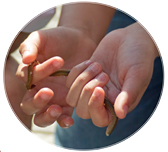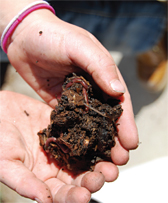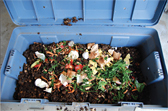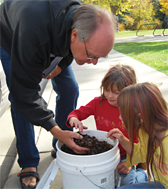Wiggly Wonders: Vermicomposting
04 Sep 2009
If you’re interested in environmental sustainability, vermicomposting is one can of worms you’ll want to open.
 “Starve a landfill. Feed a worm.”
That’s a mantra John Anderson, aka “Worm Man,” has recited for a decade. Traveling the Front Range in his refurbished ’75 Dodge “Wormbulance,” Anderson serves as the self-appointed spokesman for what he lovingly refers to as “the lost art of vermicomposting.”
He repeated the mantra again as he handed me a 5-gallon bucket packed with more than 1,200 writhing worms and assured me that my 40 bucks and time building a home for them would be well spent. Soon, my new houseguests will become composting superheroes, devouring kitchen scraps and pooping out bacteria-rich compostable castings that put chemical-laden Miracle-Gro to shame.
“This is my life, not just my business,” says Anderson, 54, a master composter and founder of Fort Collins–based Garbage Busters, a traveling resource for all things worm. “So much of the stuff that goes into the landfill is organic matter,” he says. “If it came from the land, it should go back to the land without poisoning it. Worm composting is an ideal way to make that happen.”
“Starve a landfill. Feed a worm.”
That’s a mantra John Anderson, aka “Worm Man,” has recited for a decade. Traveling the Front Range in his refurbished ’75 Dodge “Wormbulance,” Anderson serves as the self-appointed spokesman for what he lovingly refers to as “the lost art of vermicomposting.”
He repeated the mantra again as he handed me a 5-gallon bucket packed with more than 1,200 writhing worms and assured me that my 40 bucks and time building a home for them would be well spent. Soon, my new houseguests will become composting superheroes, devouring kitchen scraps and pooping out bacteria-rich compostable castings that put chemical-laden Miracle-Gro to shame.
“This is my life, not just my business,” says Anderson, 54, a master composter and founder of Fort Collins–based Garbage Busters, a traveling resource for all things worm. “So much of the stuff that goes into the landfill is organic matter,” he says. “If it came from the land, it should go back to the land without poisoning it. Worm composting is an ideal way to make that happen.”
 His philosophy is catching on, as home gardeners, schools, soup kitchens and grocery stores embrace the once obscure, undeniably icky hobby of vermicomposting. Unlike conventional compost piles that must be regularly turned, require a delicate mix of brown and green plant material, and tend to be neglected during winter, worm compost bins will operate year-round indoors, with very little maintenance.
“Very few people have yards big enough to produce all the ingredients for a proper hot composting pile,” Anderson says. “If they don’t do it properly, it gets sour and stinky and attracts pests.” But a large-enough worm bin can absorb all of a household’s yard and food wastes, he says. It’s easy, too. You can toss scraps straight into the bin after dinner, as well as any garden weeds you plucked earlier in the day. And, Anderson passionately points out, the trash man will have that much less garbage to haul to the landfill.
Not just any worm is up to vermicomposting. Eisenia fetida, or “red wigglers,” are best suited for it due to their voracious appetite and fast reproduction. A well-maintained population will eat at least half its weight in organic matter each day, and double in population every three to four months (there are roughly 1,200 worms per pound). That means my new pound of worms will eat one-half pound of kitchen scraps today and a pound a day by summer. (And when I have enough worms, I’ll share some with friends.)
His philosophy is catching on, as home gardeners, schools, soup kitchens and grocery stores embrace the once obscure, undeniably icky hobby of vermicomposting. Unlike conventional compost piles that must be regularly turned, require a delicate mix of brown and green plant material, and tend to be neglected during winter, worm compost bins will operate year-round indoors, with very little maintenance.
“Very few people have yards big enough to produce all the ingredients for a proper hot composting pile,” Anderson says. “If they don’t do it properly, it gets sour and stinky and attracts pests.” But a large-enough worm bin can absorb all of a household’s yard and food wastes, he says. It’s easy, too. You can toss scraps straight into the bin after dinner, as well as any garden weeds you plucked earlier in the day. And, Anderson passionately points out, the trash man will have that much less garbage to haul to the landfill.
Not just any worm is up to vermicomposting. Eisenia fetida, or “red wigglers,” are best suited for it due to their voracious appetite and fast reproduction. A well-maintained population will eat at least half its weight in organic matter each day, and double in population every three to four months (there are roughly 1,200 worms per pound). That means my new pound of worms will eat one-half pound of kitchen scraps today and a pound a day by summer. (And when I have enough worms, I’ll share some with friends.)
 Worms should be kept indoors in a plastic tote, a wooden box or a cooler lined with shredded newspaper. They eat pretty much anything that originally came out of the ground, including fruit and vegetable scraps, tea bags, coffee filters, yard waste, pasta, bread, paper and cardboard (the smaller the pieces, the faster they disappear). But don’t feed them meat, bones, oils and fats, or too much acidic food like vinegar and citrus fruits.
“The mite population explodes if you have too much fruit in there,” explains Nancy Dudek, a devout vermicomposter who keeps a worm bin in her kitchen and teaches -vermicomposting workshops for Eco-Cycle.
Worms should be kept indoors in a plastic tote, a wooden box or a cooler lined with shredded newspaper. They eat pretty much anything that originally came out of the ground, including fruit and vegetable scraps, tea bags, coffee filters, yard waste, pasta, bread, paper and cardboard (the smaller the pieces, the faster they disappear). But don’t feed them meat, bones, oils and fats, or too much acidic food like vinegar and citrus fruits.
“The mite population explodes if you have too much fruit in there,” explains Nancy Dudek, a devout vermicomposter who keeps a worm bin in her kitchen and teaches -vermicomposting workshops for Eco-Cycle.
Worms Gone Wild!
Worms don’t work alone, Anderson says. An army of tiny bacteria, fungi and protozoa breaks the food down into tiny pieces before the toothless worms can digest it in their gizzards, so don’t be alarmed to find other creepy-crawlies or even a little fuzz growing in your bin from time to time. “What comes out the end of a worm is 90 percent bacteria and fungi,” Anderson says, “which exude all the growth hormones and regulators that make for healthy soil.” Some research has shown that greenhouse growers who use worm castings (essentially compost with the look and consistency of chocolate cake crumbs) grow stronger plants with less disease and a longer shelf life. “It’s probably one of the best things you can put on your plants,” Anderson says. You’ll need to harvest castings every three to four months, and add fresh bedding to the bin. To obtain castings, remove all the food remnants and don’t feed the worms for a few days. Then move all of the bin’s contents to one side and add fresh bedding to the empty side. Moisten the bedding, add a few cups of garden soil and eggshells, and bury some food scraps in it. Gradually, the hungry worms will move to the bedding side where the food is. Keep applying food only to the new bedding and, after a month, remove castings from the now-deserted side (minus the paper scraps) to spade into your garden soil. Wear gloves, as you’ll certainly find a few stray worms in the castings compost. Both Anderson and Dudek have seen a marked increase in vermicomposting. “My workshops are just swamped. I’ve never had a response like this,” says Dudek, who instructs teachers in the Boulder Valley and Saint Vrain school districts on how to set up classroom worm bins and also offers school-based workshops for families. Because an estimated third of household trash is kitchen waste, vermicomposting appeals to those who want to go beyond recycling in their effort to live sustainably. Plus, it’s a fun family activity. “Kids are so into worms,” Dudek says.
Anderson has set up worm bins on horse farms (where the worms speed up manure decay), at soup kitchens and in schools across the Front Range. He also collects thousands of pounds of scraps from local restaurants and grocery stores to feed to the writhing red wigglers that inhabit the five, 40-foot-long beds on his farm near Fort Collins. When they reproduce, he sells the babies (often meeting with clients like me at an agreed-upon location). When his worms relieve themselves, he sells that, too.
“People need to stop paying someone else to move their garbage around,” Anderson says. “It can be their power if they just stop giving it away.”
Because an estimated third of household trash is kitchen waste, vermicomposting appeals to those who want to go beyond recycling in their effort to live sustainably. Plus, it’s a fun family activity. “Kids are so into worms,” Dudek says.
Anderson has set up worm bins on horse farms (where the worms speed up manure decay), at soup kitchens and in schools across the Front Range. He also collects thousands of pounds of scraps from local restaurants and grocery stores to feed to the writhing red wigglers that inhabit the five, 40-foot-long beds on his farm near Fort Collins. When they reproduce, he sells the babies (often meeting with clients like me at an agreed-upon location). When his worms relieve themselves, he sells that, too.
“People need to stop paying someone else to move their garbage around,” Anderson says. “It can be their power if they just stop giving it away.” 











